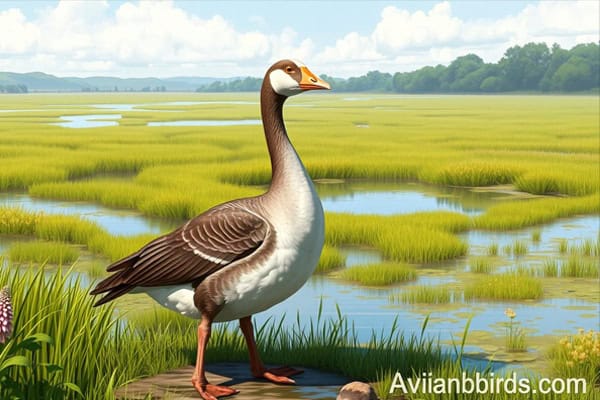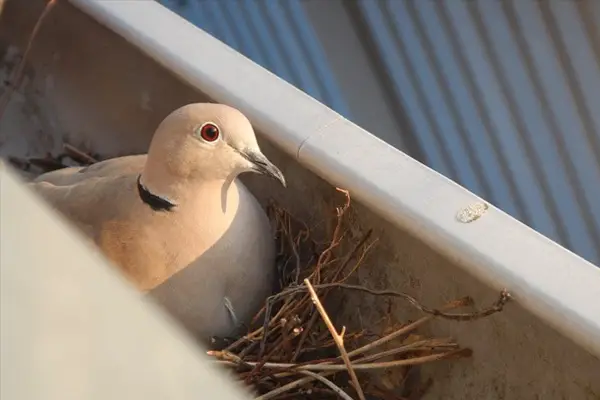Greater White-Fronted Goose: Facts & Habitat
Did you know the global breeding population of the Greater White-Fronted Goose is about 2.1 million? This shows how important they are in North America’s bird world. They have brown bodies, white faces, and pinkish-orange bills. Spotting them is fun, especially when they migrate.
This goose lives in the arctic tundras of North America to breed. Then, they move to wetlands and fields for winter. They can gain up to 30% of their body weight before migrating. This helps them survive long journeys.
Learning more about the Greater White-Fronted Goose’s habitat and behavior is interesting. You’ll see their role in the ecosystem. For example, the Tule Goose has only 7,500 members. Their presence shows how healthy our ecosystems are.
Introduction to the Greater White-Fronted Goose
The Greater White-Fronted Goose is a bird that stands out. It has unique features and a special way of moving. Its size and looks make it interesting, and it has many types within it. This shows how well it can adapt to different places.
Physical Characteristics
This bird is easy to spot because of its looks. It has brown feathers with white near its bill. Its legs are orange. Adults are 3.5 to 5.1 kg and 60-75 cm long.
Its wingspan is 130 to 165 cm. This lets it fly well. The white feathers on its back are most visible when it flies. It’s bigger than a Ross’s Goose but smaller than a Canada Goose.
Common Names and Subspecies
This bird is known by many names. In Spanish, it’s called “Ánsar Careto.” The French call it “Oie rieuse.” It has many types, each suited to different places.
The “Tule Goose” is a darker type found in Alaska. It breeds there before going to California. Other types migrate to Ireland and Scotland for winter. Knowing these names and types helps us understand this bird better.

What makes a Greater White-Fronted Goose-like sound?
Habitat of the Greater White-Fronted Goose
The Greater White-Fronted Goose needs certain habitats for its life cycle. These places help with nesting, migration, and surviving the winter. Knowing where they like to live helps us protect them and keep their numbers up.
Nesting Areas
Nesting spots for these geese are in tundra near wetlands, rivers, and ponds. They like areas full of grass and sedges because they keep their babies safe. Their nests are simple and made of plants and feathers.
A nest usually has 1 to 8 eggs. The eggs hatch in 22 to 27 days.
Migratory Habitats
When they migrate, Greater White-Fronted Geese go to different places. They eat in wet sedge meadows, tidal flats, and various wetlands. These places give them the food they need to reach their breeding grounds.
They look for areas with lots of food. This helps them stay strong on their journey.
Winter Roosting Sites
In winter, they gather at open lakes and ponds. They stay near fields where they can eat grains like barley and corn. This helps them get food easily and find safe places to rest.
| Habitat Type | Description | Key Features |
|---|---|---|
| Nesting Areas | Tundra habitats near wetlands | Dense grass and sedges |
| Migratory Habitats | Wet sedge meadows and tidal flats | Nutritionally rich environments |
| Winter Roosting Sites | Open lakes and ponds | Proximity to agricultural fields |
Behavior and Diet of the Greater White-Fronted Goose
The Greater White-Fronted Goose has interesting behavior and diet, which help it survive and live well with others. It eats different foods based on the season and where it is.
Its family bonds are strong, which helps the family stay together and pass on important traits. The family lives in many different places.
Feeding Habits
These geese mainly eat grasses, grains, stems, roots, and berries. In summer, they look for food in wet areas and ponds, where they find many fresh plants.
In winter, they eat grains and seeds in fields. This change helps them stay strong and healthy all year.
Social Structure
The Greater White-Fronted Goose’s social life is very important. They live in close families, with young staying with their parents for a long time. This helps protect the nest and teaches important survival skills.
When they migrate, they fly in “V” shapes, which shows their teamwork. They communicate with each other using body language and honking, which helps them warn each other and mark their territory.
| Aspect | Description |
|---|---|
| Mean Mass | 2.72 kg (range: 1.93 – 3.31 kg) |
| Average Length | 71.12 cm (range: 64 – 81 cm) |
| Breeding | Once a year, with clutches averaging 5 eggs |
| Incubation Period | 22 – 27 days |
| First Flight | 38 – 45 days after hatching |
| Lifespan | Up to 20.3 years in the wild; 47 years in captivity |
| Group Size | Less than 30 after breeding; large flocks outside breeding season |
Conservation Status of the Greater White-Fronted Goose
The Greater White-Fronted Goose’s conservation status shows both good news and challenges. The global breeding population is stable, but we need to watch specific trends closely. This knowledge helps us do better conservation work.
Population Trends
The U.S. Fish and Wildlife Service reports a stable population from 2007 to 2016. The global breeding population is about 2.1 million. Most are in North America, and the numbers have been increasing over the past 40 years.
Many migrate through places like South Dakota in spring and fall. They are often seen. The IUCN says they are not critically threatened, classifying them as “Least Concern.”
Threats and Protection Measures
Even with stable numbers, the Greater White-Fronted Goose faces threats. Habitat loss and climate change are big challenges. The Tule Goose, a subspecies, is more vulnerable because of its small range.
Protecting them is key, with rules on hunting and managing wild populations. Groups like the U.S. Fish and Wildlife Service watch over them. They work to keep these geese safe.
| Aspect | Details |
|---|---|
| Population Size | Estimated between 10,000 – 100,000 individuals |
| Short-Term Trend | Increase of >10% in the Pacific Flyway population |
| Date Status Assigned | January 23, 2009 |
| Date Last Reviewed | March 05, 2015 |
| Number of Occurrences | 81 to >300 |
| Range Extent | 200,000-2,500,000 square km |
| Conservation Need | Management and protection efforts must focus on habitat preservation |
Read More🐦Related Articles:
| Bar-Headed Goose: High-Flying Himalayan Marvel |
| Woodpeckers in Wisconsin |
| Woodpeckers in Texas |
| Kingfisher Bird |
| Types Of Hawks Around The World |
Conclusion
The Greater White-Fronted Goose is very important in North America. It shows amazing behaviors and strong family bonds. It lives in many places, from the big arctic tundras to wetlands and fields.
Knowing where it lives helps us appreciate it more. It also helps us work better to protect it.
The goose’s health shows both good and bad things. Studies at places like Shengjin Lake have seen more geese because of better care. But, changes in where it lives and what it eats still affect it.
Knowing about the goose’s home and how it behaves helps us protect it. Your help is key to ensuring future generations can see this amazing bird. By working together, we can keep the Greater White-Fronted Goose safe for years to come.
Frequently Asked Questions
Q1. What is another name for the white-fronted goose?
Another name for the white-fronted goose is the “Anser albifrons.”
Q2. How do you identify a white-fronted goose?
You can identify a white-fronted goose by its distinctive white patch on the forehead and a generally grayish-brown body. They also have a short neck and a black tail with a slightly orange bill.
Q3. Is a Snow Goose a white-fronted goose?
No, a Snow Goose is not a white-fronted goose. They are different species, with the Snow Goose (Chen caerulescens) having a different body shape and coloration, including white and gray morphs.
Q4. Why is the lesser white-fronted goose endangered?
The lesser white-fronted goose is endangered due to habitat loss, hunting, and climate change, which have significantly reduced its breeding and feeding areas. Conservation efforts are ongoing to protect this species.






